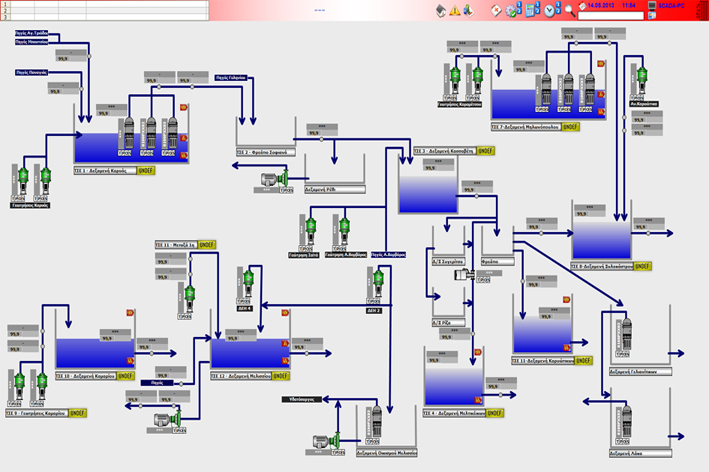PROJECT DESCRIPTION
This system enables the monitoring, remote control, remote operation, and leak detection of the main water supply network of the Municipality of Xylokastro.
- Twelve (12) Local Control Stations (LCS) for hydraulic Central Network were installed at key points of the water supply network. They collect data from the connected components—such as flow rates, pressures, etc.—and transmit them via a GSM wireless network to the Central Control Station (CCS) for further processing. Depending on demand, they can adjust the pressure in the network zones they monitor, thereby reducing network leaks as well as damage caused by high pressure (e.g., pipeline bursts). This extends the lifespan of the network and simultaneously saves water for the Municipal Water and Sewerage Company of Xylokastro
- A Central Control Station (CCS), where operators can access and control all or part of the system’s functions using an appropriate password. Information on the operational status and system faults is provided through the remote monitoring/control software (SCADA).
BRIEF DESCRIPTION OF OPERATION
- Springs – Boreholes – Reservoirs
The system continuously monitors by the supply from the springs, the system issues a command to stop the operation of the boreholes. In cases where the spring supply is insufficient to meet consumption needs, appropriate alerts are sent to the operator, and the borehole pumps are automatically activated. The system also constantly monitors the readings from the flow meters, and when these readings exceed the permitted limits, appropriate messages are issued to the operator.
- Water Pumping Station – Reservoirs
The water level of the inlet reservoir,, η the outflow at the pumping station's exit, and the level of the reservoir supplied by the pumping station are continuously monitored. When the reservoir level reaches the lower permissible limit, a command is issued to start a pump.The system selects to start the pump with the fewest operating hours first, followed by the pump with the next fewest hours, and so on. This ensures balanced usage across all pumps. If the inlet reservoir’s water level drops below the minimum allowed limit, appropriate warning messages are sent to the operator, and the necessary actions are automatically carried out—such as stopping of the operation of the pumps.
- Finally, all the above information is collected at the Central Control Station (CCS), located at the offices of the Municipal Water and Sewerage Company. From there, the operators take the appropriate actions to ensure the optimal operation of the system.
For the operation of the remote monitoring and control system, the following equipment was installed:
One (1) Central Control Station (CCS) with the following auxiliary equipment:
- One (1) communication processor
- One (1) PC (Personal Computer)
- One (1) monitor
- One (1) laptop computer
- One (1) UPS (Uninterruptible Power Supply)
- Two (2) software programs for computer use
- One (1) Remote Monitoring/Control software program (SCADA)
- One (1) software package for local and remote programming of PLCs.
Twelve (12) Local Control Stations (LCS) at boreholes and reservoirs, including the following equipment:
- Twelve (12) PLC programming software licenses
- Eighteen (18) electromagnetic flow meters
- Seven (7) analog pressure sensors
- Seven (7) analog level sensors
- Thirteen (13) level switches
- Thirteen (13) current transducers for current transformers (CTs)
- Twelve (12) electrical installations housed in pillars.
Benefits of the system during operation:
- the timely identification of the source of potable water losses and the immediate response to leaks and overflows, resulting in the reduction of annual losses and overall consumption within the Municipality's water supply network.
- the reduction of the pumping station's energy consumption through controlled pump operation, as well as their protection from voltage faults, water shortages, etc.
- the continuous recording of consumption (inflows and outflows of the reservoirs and the network), which provides information on any significant leaks.
- the immediate notification and response of the responsible technical personnel to any faults (24-hour monitoring), such as pump failure (water shortage in the network), sudden pressure drop (leak), or sudden flow increase (pipeline break).




